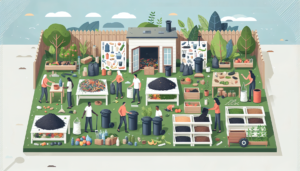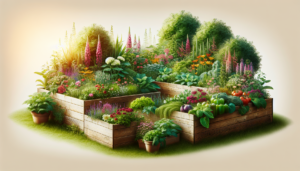Growing Perfect Tomatoes: Essential Gardening Tips
Growing Perfect Tomatoes: Essential Gardening Tips
Imagine picking a juicy, ripe tomato from your backyard. The vibrant color and burst of flavor are amazing. Plus, knowing you grew it from seed to harvest is special.
But what makes a tomato perfect? The kind that everyone loves? We’ll explore the secrets to growing these amazing tomatoes.
In this guide, we’ll share the secrets to growing delicious tomatoes at home. We’ll cover choosing the right varieties, preparing the soil, and managing pests. You’ll learn everything you need to know to become a tomato-growing expert.
Key Takeaways
- Discover the health benefits of homegrown tomatoes
- Understand the different tomato varieties and their unique characteristics
- Learn the essential techniques for preparing the perfect soil for your tomato plants
- Explore the best methods for supporting and pruning your tomato plants
- Unlock the secrets to a thriving, disease-resistant tomato crop
Why Growing Tomatoes Is Perfect for Every Garden
Tomatoes add a lot to any garden, big or small. They’re full of nutrients and come in many varieties. This makes growing tomatoes a great choice for all gardeners.
Health Benefits of Home-Grown Tomatoes
Homegrown tomatoes are packed with vitamins and antioxidants. They have vitamin C, vitamin K, and folate. Plus, they contain lycopene, which helps fight certain types of cancer and heart disease. Growing your own tomatoes means your family gets the best nutrition from your garden.
Understanding Different Tomato Varieties
There are countless tomato types, from beefsteak to cherry and grape. Each variety suits different tastes and needs. Determinate plants are great for container gardening. Indeterminate varieties grow more and are best for bigger gardens.
Space Requirements for Tomato Plants
- Determinate varieties: Require 2-3 feet of space between plants
- Indeterminate varieties: Require 3-4 feet of space between plants
- Cherry and grape tomatoes: Can thrive in smaller containers or hanging baskets
With the right planning and tomato variety, you can add tomato plants to any garden. This works for big backyards or small balconies.
Best Soil Preparation Techniques for Tomatoes
Healthy tomato plants start with the right soil. To grow juicy, flavorful tomatoes, your garden or container needs the perfect soil. Let’s look at how to prepare your soil for a great tomato harvest.
Optimize Soil pH
Tomatoes love slightly acidic soil, with a pH of 6.0 to 6.8. Test your soil and adjust it if needed. If it’s too acidic, add lime. If it’s too alkaline, use sulfur or compost to make it more acidic.
Enrich with Organic Matter
Tomatoes need nutrient-rich soil. Add compost or organic matter to your soil. This improves soil structure and gives plants the nutrients they need for healthy growth.
| Soil Amendment | Benefits |
|---|---|
| Compost | Improves soil pH, increases organic matter, and provides a diverse array of nutrients. |
| Aged Manure | Enhances soil fertility and structure, while also improving water-holding capacity. |
| Peat Moss | Increases the soil pH, improving drainage and aeration for optimal tomato growth. |
By using these soil preparation tips, you’ll be ready for a great tomato harvest. Spend time now to make sure your tomatoes have the best chance to thrive.
Selecting the Right Tomato Varieties for Your Climate
Choosing the right tomatoes for your garden is crucial. There are many types, like heirloom tomatoes, hybrid tomatoes, and cold-tolerant varieties. Knowing the differences helps you pick the best for your garden.
Determinate vs Indeterminate Varieties
Consider whether you want determinate or indeterminate tomatoes. Determinate tomatoes are compact and bush-like. They grow to a certain height and produce one crop. Indeterminate tomatoes are vining and keep growing, producing fruit all season.
Disease-Resistant Tomato Types
Disease resistance is key, especially in areas with common tomato diseases. Some tomatoes, like heirloom tomatoes, may be more prone to diseases. Hybrid tomatoes often have better resistance. Choosing disease-resistant tomatoes can lead to a healthier crop.
Climate-Specific Recommendations
It’s also important to pick tomatoes that do well in your climate. Cold-tolerant varieties are great for cooler areas, while heat-loving types do better in warmer climates. Talking to local gardening experts or doing research can help you find the best tomatoes for your area.
By carefully choosing the right tomatoes for your climate, you can have a successful garden. Enjoy a harvest of delicious, homegrown tomatoes.
Essential Tips for Gardening Tomatoes Successfully
To grow lots of tomatoes, you need to focus on planting. Knowing how to start seeds and transplant is key. These steps can greatly improve your gardening success.
Proper Seed Starting and Germination
Starting tomato seeds indoors is a great way to begin. Plant them 6-8 weeks before the last frost. Make sure the soil is warm and bright.
Keep the soil moist and use bottom heat for germination. Once the seeds sprout, move them to a sunny area. Gradually get them used to the outdoors before transplanting.
Planting Techniques for Optimal Growth
- Plant tomatoes deep, burying the stems up to the first set of leaves to promote stronger root development.
- Space plants 18-24 inches apart, allowing for proper air circulation and sunlight exposure.
- Provide a sturdy support system, such as cages or stakes, to keep plants upright and prevent fruits from touching the ground.
By using these planting techniques, your tomato plants will grow strong. This will lead to a great harvest.
Initial Care and Maintenance
After planting, your tomatoes need the right care. Water them well at the base, not the leaves. Use organic fertilizer to feed them.
Watch for pests and diseases. Act fast if you see any problems.
With good tomato care, you’ll get a lot of delicious tomatoes. Your garden will be the talk of the town.
Watering and Feeding Schedule for Healthy Plants
It’s key to water and feed tomato plants right to help them grow well. Knowing how much water and nutrients they need at each stage is important. This helps you get a big harvest.
Water Requirements Throughout Growth Stages
Tomato plants need different amounts of water as they grow. In the early stages, they need about 1-2 inches of water each week. When they start flowering and making fruit, they need 2-3 inches of water weekly. Using drip irrigation helps keep the soil moist without too much water.
Organic vs Synthetic Fertilizers
Tomatoes do well with a balanced fertilizer NPK diet. Organic fertilizers like compost or manure are good because they’re gentle and sustainable. Synthetic foliar feeding can give a quick nutrient boost, but use it carefully to avoid soil salt buildup.
Signs of Over and Under Watering
- Underwatering: Wilting leaves, stunted growth, and less fruit.
- Overwatering: Yellow leaves, soft or rotten stems, and more disease.
Watching your tomato plants closely and adjusting your care can help them grow well all season.
| Growth Stage | Water Needs | Fertilizer Recommendation |
|---|---|---|
| Vegetative | 1-2 inches per week | Balanced organic or slow-release fertilizer |
| Flowering and Fruiting | 2-3 inches per week | Balanced or high-phosphorus fertilizer |
| Ripening | Consistent moisture | Potassium-rich fertilizer |
Common Tomato Plant Diseases and Prevention
Growing tomatoes is rewarding, but gardeners must watch out for diseases. Blight and fusarium wilt are big threats. Knowing the signs and how to prevent them is key to a healthy crop.
Identifying and Treating Tomato Diseases
Early blight is a common problem. It shows up as dark circles on leaves and stems. It loves warm, humid weather and can spread fast. Use copper-based fungicides or neem oil to treat it.
Fusarium wilt is another big issue. It causes plants to wilt and die. To stop it, rotate crops, use resistant varieties, and improve soil drainage.
- Regularly check plants for disease signs like discoloration or wilting.
- Use pest control to stop insects from spreading disease.
- Keep plants well-ventilated to stop fungi from growing.
- Quickly remove and throw away any sick plant parts to stop disease spread.
By being careful and using prevention methods, gardeners can keep tomatoes healthy. This way, they can enjoy a big harvest of tasty fruits.
Pruning and Support Systems for Better Yields
Getting a lot of tomatoes is not just about picking the right kind. You also need to prune right and use good support. Knowing how to stake and prune can make your tomatoes juicier and healthier.
Staking vs Caging Methods
For your tomato trellis, you can choose between staking and caging. Staking uses vertical posts, while caging uses wire or metal to keep plants upright. Each has its own benefits:
- Staking helps air move better, lowers disease risk, and supports vertical gardening.
- Caging is better for keeping plants stable, especially for tall varieties, and works well in small spaces.
Proper Pruning Techniques
Pruning is key for a healthy tomato plant. You should remove suckers – the side shoots between the main stem and leaves. This helps the plant focus on growing fruit, not too much foliage.
Use sharp pruners and cut just above a leaf node. Don’t leave stubs, as they attract pests and diseases. Start pruning when plants are 12 inches tall to keep them healthy and promote air flow.
“Proper pruning and support systems can make all the difference in your tomato yields, helping you harvest a bountiful crop of juicy, flavorful fruit.”
Harvesting Tips and Storage Solutions
Harvesting your tomatoes at the right time is crucial for their taste and texture. Watch for color changes and pick them when they’re soft but still firm. Letting tomatoes ripen on the vine is best, so don’t pick them too soon.
If you have green tomatoes left, they’re still good for many recipes. Put them in a paper bag or box and keep them at room temperature to ripen. For longer storage, canning your tomatoes is a great option to enjoy summer flavors all year.
Storing tomatoes right is key to keeping them fresh longer. For quick use, keep ripe tomatoes at room temperature, away from sunlight. For longer storage, the fridge is okay, but it might affect their taste and feel. Try different ripening on the vine and storage methods to enjoy every bite of your tomatoes.
FAQ
What are the health benefits of growing your own tomatoes?
Home-grown tomatoes are full of vitamins, minerals, and antioxidants. They are a nutritious addition to any diet. Growing your own tomatoes means you get the freshest, tastiest produce without chemicals or preservatives.
What are the different types of tomato varieties I can grow?
There are many tomato varieties, like heirloom, hybrid, determinate, and indeterminate. Each has its own size, shape, color, and taste. You can pick the best for your climate and taste.
How much space do I need to grow tomato plants?
The space needed for tomato plants varies by type and your garden. Determinate plants need 2-3 feet, while indeterminate ones need 4-5 feet. If you have little space, container gardening works, as long as the pots are big enough.
What is the ideal soil preparation for growing tomatoes?
Tomatoes love well-drained, rich soil with a pH of 6.0 to 6.8. Adding compost or organic matter improves the soil. This makes it perfect for your tomato plants.
How do I choose the right tomato varieties for my climate?
Choose tomato varieties based on your local climate. Consider temperature, rainfall, and frost. Pick disease-resistant ones and decide between determinate and indeterminate based on space and harvest time.
What are the key steps for successfully planting and caring for tomato seedlings?
Plant tomatoes correctly for healthy growth. Use the right depth and spacing. Also, water, sun, and nutrients at each stage are crucial for strong plants and high yields.
How do I properly water and fertilize my tomato plants?
Tomatoes need the right water and nutrients at each stage. Keep the soil moist but avoid too much water. Use organic or balanced fertilizers for healthy growth and fruit.
What are some common tomato plant diseases, and how can I prevent them?
Tomatoes can get diseases like blight and wilt. Prevent these by choosing resistant varieties, rotating crops, and improving air circulation.
How do I properly prune and support my tomato plants?
Pruning and supporting plants helps their health and yields. Remove suckers and train plants vertically. This improves airflow, prevents disease, and boosts fruit.
When is the best time to harvest tomatoes, and how do I store them?
Harvest tomatoes when they’re fully ripe. Ripe tomatoes taste better. For longer storage, try canning, freezing, or dehydrating.













